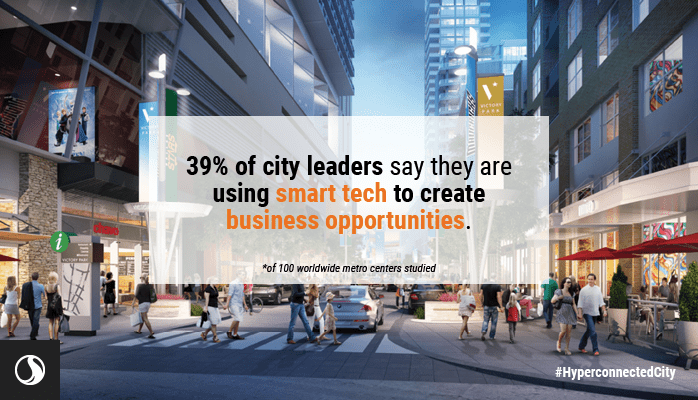According to the study, 38% of cities deploying smart mobility solutions are bolstering customer satisfaction and 32% are improving productivity and delivery times for business. Likewise, 45% of cities deploying smart environmental and energy initiatives are improving citizen health, 44% are reducing pollution, and 43% are stabilizing energy prices.
The speed of technological change has been brisk. Public Wi-Fi, Internet of Things, cloud, and mobile technology are now pervasive across cities, used by more than 9 out of 10 them in the study. Other commonly used technologies include biometrics (83% of cities), artificial intelligence (82%), and Blockchain (66%). Robots and drones, 5G, augmented reality, and distributed computing are promising new technologies, which are still in earlier stages of investment.
By using these technologies to transform and interconnect their urban ecosystem, government leaders aim to deliver a myriad of benefits to their stakeholders. These include creating new business opportunities, filling talent gaps, improving public health, reducing crime, boosting productivity and addressing income inequality. These benefits work together to deliver a virtuous circle of economic prosperity, business growth, and social well-being.
“The research we are pursuing with ESI is providing valuable insight into how cities are approaching smart technologies – what they see as their top priorities, their pain points, and their solutions,” said Nancy MacDonald, Stantec’s Smart Cities Lead. “Making the places we live more vibrant, healthy and resilient through thoughtful design requires taking a community-first approach – and that means understanding community priorities.”
The ROI on smart initiatives
These same smart programs also generate economic and financial gains that not only cover the cost of investment, but also provide tangible returns. Except for predictive policing, all 62 smart city initiatives studied showed positive investment returns. The smart city dimensions providing the largest gains include:
- Mobility and transportation: curb management (4.5%), congestion charging (4.3%)
- Energy and water: dynamic electricity pricing (4.8%), renewable energy (4.3%)
- Environment: optimizing waste collection (4.1%), real-time water quality monitoring (3.9%)
- Public safety: first aid alerts (5.6%), gunshot sensors (4.8%), real-time crime mapping (4.7%)
- Governance: digital business licensing (5%), digital payments (4.6%)
However, if not managed effectively, these smart initiatives can also expose urban areas to higher cyber risks. For cities in the survey, the total cost of cyber loss events over the last year averaged $3.4 million, with 10% suffering losses between $10m and $20m. Over half of the cities said that they were not well prepared for cyberattacks. The biggest vulnerabilities cited were financial and payment systems (54% of cities), IT infrastructure and telecoms (51%), and mobility and transportation (40%). To cope with rising cyber risks, 82% of cities plan to increase their cybersecurity budgets next year, 39% by more than 10%.
The study is based on a rigorous benchmarking survey conducted over the summer of 2019 by ESI ThoughtLab and a cross-industry coalition of sponsors, including Deloitte, Oracle, Stantec, Pennoni, Eaton Lighting, NTT Group, Nokia, Cognizant, Visa, and Microsoft. The sample consisted of 100 worldwide cities engaged in smart city initiatives. Cities varied in size from 123,000 to over 24 million residents and represented a range of income levels, regions, and stages of economic development.
“Our research shows that hyperconnected cities—ones that use technology to transform and interconnect their urban assets—generate demonstrable ROI for their economies, while providing enormous improvements in living and business conditions,” said Lou Celi, CEO of ESI ThoughtLab and director of the study.
Full findings from the study will be released in November at the Smart City Expo World Congress in Barcelona. More information can be found by visiting: https://econsultsolutions.com/esi-thoughtlab/hyperconnected-city/
About Stantec
Communities are fundamental. Whether around the corner or across the globe, they provide a foundation, a sense of place and of belonging. That’s why at Stantec, we always design with community in mind. We care about the communities we serve—because they’re our communities too. This allows us to assess what’s needed and connect our expertise, to appreciate nuances and envision what’s never been considered, to bring together diverse perspectives so we can collaborate toward a shared success. We’re designers, engineers, scientists, and project managers, innovating together at the intersection of community, creativity, and client relationships. Balancing these priorities results in projects that advance the quality of life in communities across the globe.
Stantec trades on the TSX and the NYSE under the symbol STN.
About ESI ThoughtLab
ESI ThoughtLab is an innovative research firm providing fresh ideas and actionable insights through rigorous data analysis. We specialize in assessing the impact of technological, economic, and demographic shifts on companies, industries, and cities. ESI ThoughtLab ’s team of seasoned economists and thought leaders have many years of experience in conducting urban analysis.



